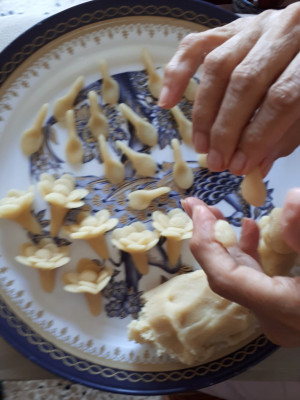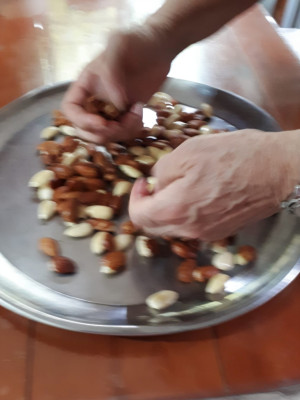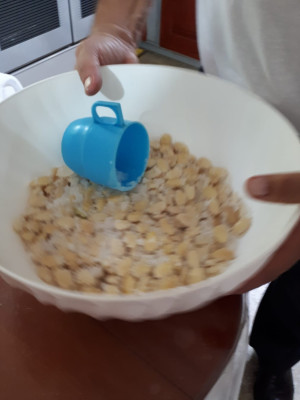Marsaben / Marzipan
 Marsaben/marzipan is a sweet made from marzipan that is known in several countries. The story of its arrival in Zouk Mikhail, place of its origin, is not dated but rather counted in generations. The memory of the inhabitants retains that this story began, five generations ago, when a European traveler passing through noticed the importance of the almond harvest in Zouk. She made the decision to pass on to the nuns of the convent the recipe for an almond-based confectionery called “marzipan”. In turn, they taught this know-how to the inhabitants of Zouk. This is how marsaben appeared and spread to many other localities such as Feghal, Damour, etc.
Marsaben/marzipan is a sweet made from marzipan that is known in several countries. The story of its arrival in Zouk Mikhail, place of its origin, is not dated but rather counted in generations. The memory of the inhabitants retains that this story began, five generations ago, when a European traveler passing through noticed the importance of the almond harvest in Zouk. She made the decision to pass on to the nuns of the convent the recipe for an almond-based confectionery called “marzipan”. In turn, they taught this know-how to the inhabitants of Zouk. This is how marsaben appeared and spread to many other localities such as Feghal, Damour, etc.
 Marsaben’s recipe is simple, but the techniques for making the confectionery in the form of flowers require a lot of dexterity and creativity. The almonds are blanched to facilitate peeling. The almond hearts are pounded in a brass mortar to reduce them to a powder. Orange flower water and rose water and sugar are added to the powder. The ingredients are mixed to obtain an oily paste.
Marsaben’s recipe is simple, but the techniques for making the confectionery in the form of flowers require a lot of dexterity and creativity. The almonds are blanched to facilitate peeling. The almond hearts are pounded in a brass mortar to reduce them to a powder. Orange flower water and rose water and sugar are added to the powder. The ingredients are mixed to obtain an oily paste.
 Then, the practitioner delicately creates marsaben flowers. Each flower petal is shaped by hand, then assembled into a flower. The flowers are left in the open air to dry for a few hours before being put in the oven. each producer of these flowers is recognizable by the shape she gives to the flowers, a product of her creativity.
Then, the practitioner delicately creates marsaben flowers. Each flower petal is shaped by hand, then assembled into a flower. The flowers are left in the open air to dry for a few hours before being put in the oven. each producer of these flowers is recognizable by the shape she gives to the flowers, a product of her creativity.
Over the past ten years, the utensils used in the preparation of marsaben have evolved without modifying the recipe or its preparation methods. The brass mortar was replaced by a grinding machine. The gas oven replaced the traditional cooking method. Marsaben is the great pride of the women who produce it. They try as much as possible to save it by passing on their know-how to their daughters and granddaughters.
However, despite the good will of its bearers, marsaben as an element of intangible cultural heritage is threatened with disappearance. A disease attacked the almond orchards drying out the trees. The local production of almonds has dropped significantly, forcing producers to buy them on the market, increasing the cost of production.
Marsaben’s sale in sweet shops in large urban centers led to decontextualization and over-commercialization. Practitioners do not receive orders from merchants who make their own products themselves with excessive use of sugar and chemicals. From now on obtained thanks to a mould, the shape of the confectionery became simpler allowing a greater production and, consequently, a maximization of the profits.

